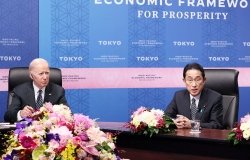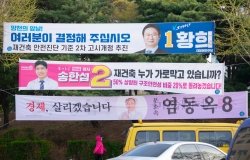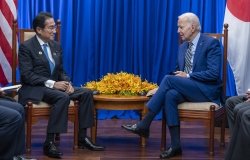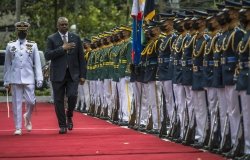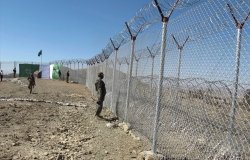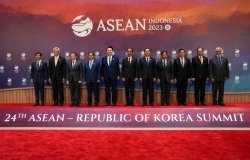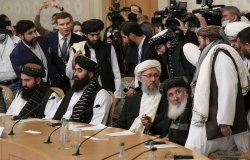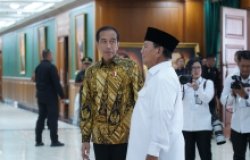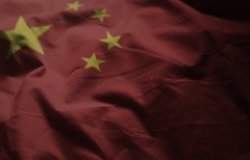
A blog of the Indo-Pacific Program
The Myanmar Junta Under Siege
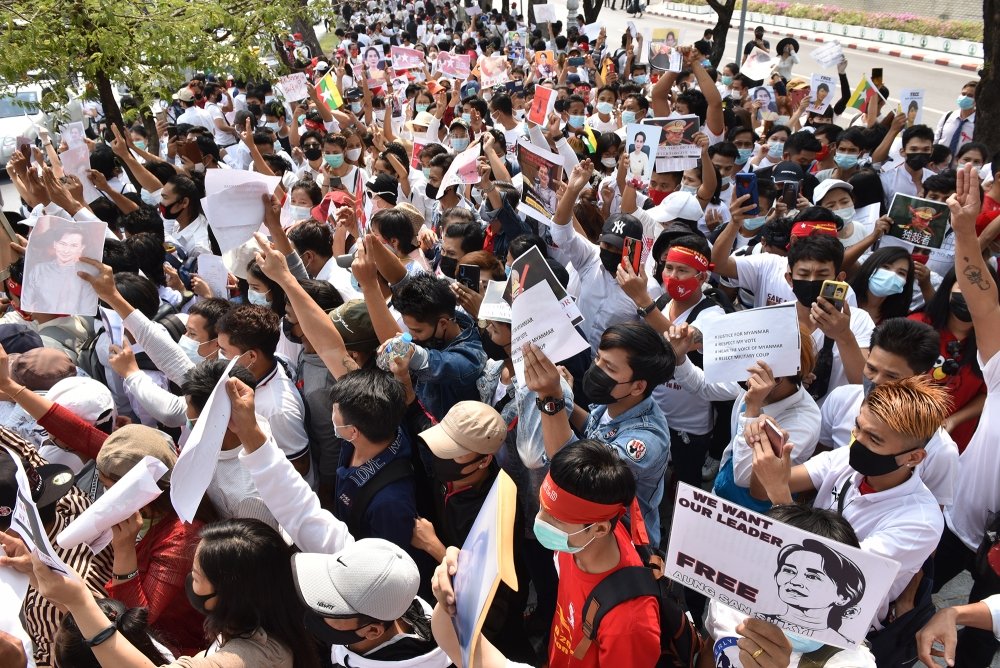
teera.noisakran / Shutterstock.com
On April 9th, the Karen National Liberation Army—the armed wing of the ethnic armed organization, the Karen National Union (KNU)—units from a formerly military-aligned Border Guards Force that has pulled back from the junta, and elements of the People’s Defense Forces (PDFs) seized the Myanmar side of a border crossing in the city of Myawaddy along the Thai border. Although fighting continues in the city of 200,000 and the junta can be expected to retaliate via the air, the apparently impending fall of Myawaddy caps off a five-month string of resistance successes on the battlefield in Myanmar.
With the Myanmar junta continuing to lose ground to the loose (but growing) coalition of pro-democracy forces, led by the civilian National Unity Government (NUG), and ethnic armed groups, the balance of power in Myanmar is shifting against the military. From a strategic perspective, it is increasingly evident that the military’s hold on power is slipping, but the resistance likely needs more leverage to achieve its Spring Revolution. The international community should therefore refrain from pushing the pro-democracy resistance to negotiate before it is ready.
Falling Dominoes Along Myanmar’s Periphery
After slowly building momentum leading into 2023, resistance forces fighting the Myanmar military that seized power in a coup in February 2021 have seized significant territory and towns throughout Myanmar in a stunning series of offensives over the past five months.
On October 27th, 2023, the Three Brotherhood Alliance of the Arakan Army (AA), Myanmar National Democratic Alliance Army (MNDAA), and Ta’ang National Liberation Army (TNLA) suddenly attacked junta targets throughout northern Shan State along the border with China. Previously, the groups had quietly backed anti-junta forces but declined to the enter the war directly. But, in October 2023, the Three Brotherhood Alliance took advantage of Chinese consternation about international crime to seize major towns and cut key highways. This marked the first instance of significant losses of towns and revenue by the junta. Signaling the junta’s crumbling morale, entire battalions now regularly surrender in the months since October.
Taking advantage of the junta’s weakness, the Arakan Army soon launched its own highly successful offensive in Rakhine State on Myanmar’s western edge. The Arakan Army has taken six out of 17 townships in the state and has now neared the port of Kyaukphyu, a vital terminus for the China-Myanmar Economic Corridor with a strategic oil and gas pipeline. The AA shows few signs of halting its offensive as it approaches Sittwe, the state capital. It clearly harbors ambitions of taking the whole western seaboard.
Resistance gains are far from limited to the Three Brotherhood Alliance. To the north of Rakhine, Chin resistance forces—along with AA—have steadily wrapped up junta forces along the Myanmar-India border, while PDFs and the Kachin Independence Army (KIA) are also particularly active in Sagaing Region's international borderlands. Despite losing the initially captured district capital of Kawlin in early 2024, anti-junta forces continue to make gains against the Myanmar military deeper in Sagaing and Magway Regions. Further to the north, the KIA launched its own large-scale assaults on junta positions in Kachin State in March 2024, having since seized numerous bases and the important China-Myanmar border town of Lweje.
Meanwhile, on Myanmar’s eastern side, the junta’s position is similarly shaky. The Pa-O National Liberation Organization decided to enter the war against the junta in January 2024, targeting Hsihseng town in southern Shan State. In Kayah State, anti-junta troops took most of the state capital Loikaw and the majority of the state’s territory. KNU forces in Kayin State have surrounded Kawkareik, which they had previously failed to seize in 2022. Resistance units have now also driven off junta forces from much of the Asia Highway linking Myanmar and Thailand. With the town of Myawaddy close to complete resistance control, the junta’s position in the east—and leading to Myanmar’s capital—is in real jeopardy.
Despite the junta cracking down on urban guerillas earlier in the war, the NUG and its PDFs have launched daring strikes in recent days in Myanmar’s central plains and largest urban areas. Drone operators recently gained a symbolic victory by hitting the military’s headquarters and junta head Senior General Min Aung Hlaing’s residence in the capital, Naypyidaw.
After these recent gains along the country’s periphery, the expectation is that fighting will soon spread more directly into the country’s Bamar-majority regions.
Resistance Gains and a Desperate Junta
Following five months of military gains, the resistance enters 2024 in a far better strategic position than in any of the years since 2021. Zooming out, the coalition has steadily cut the junta off from its borders with Bangladesh, India, China, and now Thailand, thus forcing it to hold on under what amounts to a nationwide siege of the country’s center. The junta is on the backfoot, an assessment supported by the lack of strategic counteroffensives and its desperate search for manpower.
There are three key takeaways for international policymakers from these developments.
For one, the war is far from over, and the junta still maintains the air power and artillery to inflict unimaginable damage upon Myanmar’s people. Indeed, it has only ramped up its terror tactics, opting to destroy Kawlin in Sagaing Region rather than see the NUG effectively govern a town. The junta sees targeting the pro-democracy NUG and PDFs and attempting (unsuccessfully so far) to split the ethnic armed groups from the rest of the anti-junta coalition as its main strategic objectives. Inflicting punishment on the population is one of the few tools left to it, and Myanmar’s humanitarian crisis can only be expected to worsen significantly due to the junta’s destructiveness.
Two, while the resistance is cooperating strategically at an unprecedented level, a political framework that satisfies Myanmar’s many diverse actors and ensures the Spring Revolution comes to fruition is still far away. Signs of concern include intra-coalition disputes over control in Chin State, the AA’s worrying statements regarding the Rohingya, and lingering frustrations with the NUG’s leadership among many youth leaders, PDFs, and ethnic minority groups.
However, despite these challenges, it is important to reiterate that Myanmar has long been “fragmented,” and the current revolution constitutes the best chance for a stable, democratic, and inclusive Myanmar. Signs of improvement include the recent hosting of a second People’s Assembly and the January 2024 joint statement by the NUG, Chin National Front, Karenni National Progressive Party, and the KNU.
Moreover, battlefield cooperation can create the trust necessary to build towards a political framework. Military coordination between the NUG and the ethnic armed organizations has improved over time. Indeed, although command and control is a perennial issue among Myanmar’s anti-junta resistance, the recent offensives across the country point towards unprecedented strategic cooperation. While motivations vary for joining the resistance offensives against the junta, many ethnic armed groups see the military’s weakened position as an opportunity and the best chance in Myanmar’s modern history for creating an inclusive, federal democracy. Importantly, Myanmar’s people remain committed and supportive of the struggle.
Third, despite the military’s desperation and a shifting balance of power, it is not the time for international actors to push the resistance to enter peace negotiations. The military remains fundamentally intransigent and the core cause of instability in Myanmar. Because the military still holds onto the large towns and cities in the Bamar heartland, its forces maintain an airpower and artillery advantage, and the resistance has not yet developed a mutually agreed-upon postwar political framework, a premature ceasefire and negotiated settlement risks “freezing” the conflict in place.
China and many of Myanmar’s other neighbors are above all concerned with stability, and Beijing in particular would be fine with an internally divided but quiescent Myanmar so long as its Belt and Road investments can continue unhindered. China out of concern for its own interests has already compelled Three Brotherhood Alliance to enter into a tenuous ceasefire with the junta in northern Shan State and is reportedly attempting another one in Rakhine State with the AA. In response to the impending fall of Myawaddy, Thailand’s prime minister recently stated that “maybe it’s time to reach out and make a deal” with the military.
But, until the battlefield situation develops to the point where the military has no choice but to accept civilian control, negotiations undertaken now—especially under China’s auspices—would not result in the Spring Revolution’s goals of an inclusive, federal democracy. Indeed, Myanmar would remain internally divided and perpetually unstable, likely with a politically active military either still in power or waiting on the wings to again leave the barracks.
With their forces continuing to make gains on the battlefield and in need of more time to advance a political framework acceptable across the coalition, the pro-democracy resistance’s demands that it will not accept a political role for the military after the war should be respected. The military will not negotiate in good faith unless it no longer believes it can survive as an institution at war with the whole country.
For policymakers in Washington, this means that the United States should expand its support for the pro-democracy resistance in Myanmar to buy them more time. Importantly, it should expand its material support, including by providing funding for the resistance’s governance and political cooperation efforts. Additionally, it should rapidly increase its humanitarian aid to reduce civilian suffering. But, above all, US policy should aim to ensure that the Spring Revolution continues to make gains against the military.
The views expressed are the author's alone, and do not represent the views of the US Government or the Wilson Center. Copyright 2024, Indo-Pacific Program. All rights reserved.
About the Author


Indo-Pacific Program
The Indo-Pacific Program promotes policy debate and intellectual discussions on US interests in the Asia-Pacific as well as political, economic, security, and social issues relating to the world’s most populous and economically dynamic region. Read more
